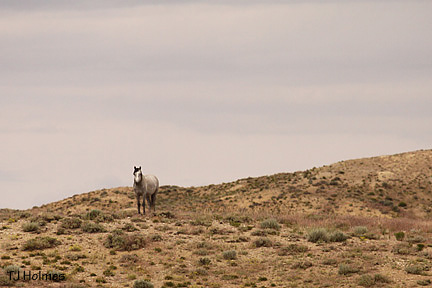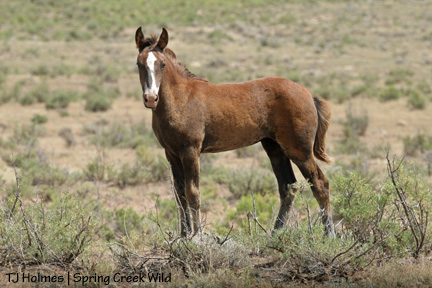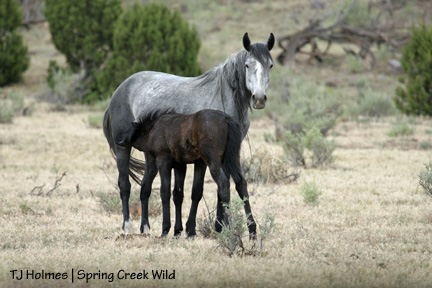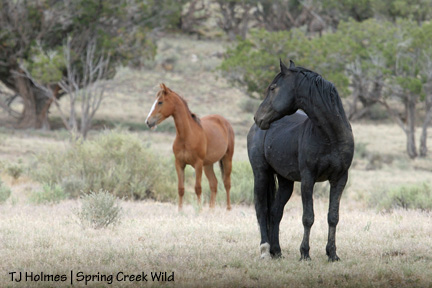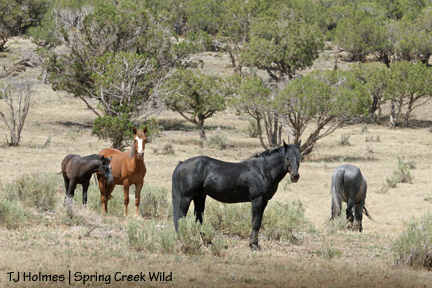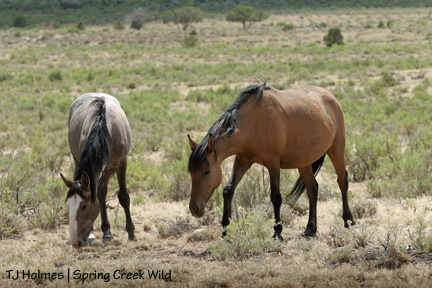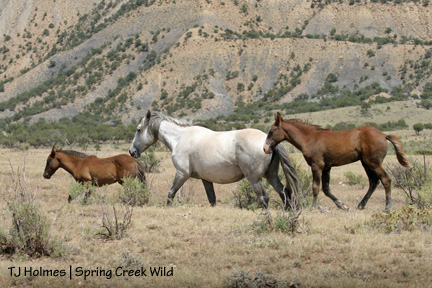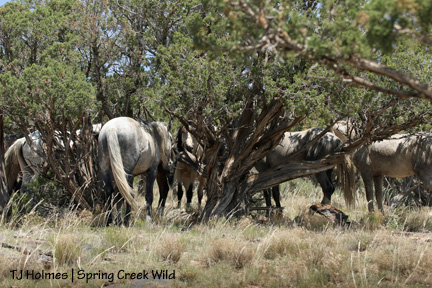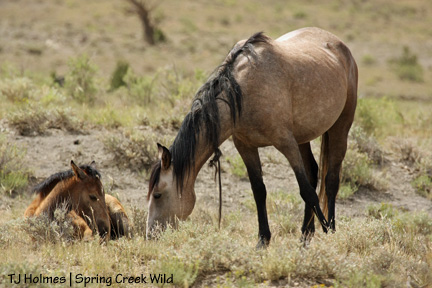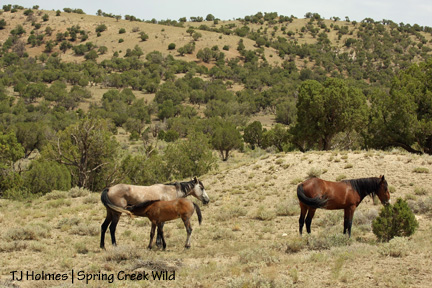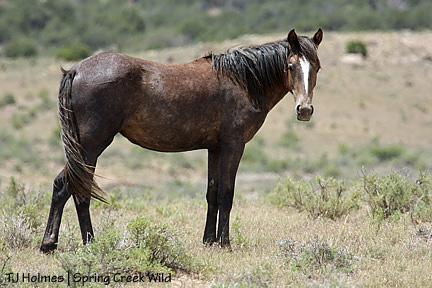
Picasso of Sand Wash Basin
This past weekend, I finally had the opportunity I’ve been anticipating since last October: a visit to Sand Wash Basin, home range of current Spring Creek Basin mares Luna (2001), Raven, Mona and Kootenai (2008). What an unforgettable experience!
Many sincere thanks to Amanda Conner who was so generous with her time, taking me out to see the horses Saturday with photographer Pam Nickoles and her husband, Tom, and Sunday morning before I had to head for home. Fantastic company all the way around, and I was thrilled to be with these particular mustang advocates during my first visit to this amazing area!
You might recognize Amanda’s name from the pictures she sent awhile back of Raven and Kootenai with their bands in Sand Wash before they were gathered last October and traveled to Spring Creek to boost our herd’s genetic diversity. She visited Spring Creek Basin in 2007 and 2008 (I think) as part of the alternative spring break program from the University of Missouri. She was already a horse girl, but seeing the mustangs inspired her to find a way to work with them. She’s about to start graduate school studying equine reproduction (yeah?!), but meanwhile, she’s an intern for the Humane Society of the United States, working on their PZP study in Sand Wash. She knows those horses like family! Lucky for us and the horses, next summer will be her third summer in *that* basin! Amanda, thank you so, so much for all you do for our wild horses!
Sand Wash Basin is amazingly familiar, sharing a lot of the same type of topography and vegetation that fills Spring Creek Basin. Some main differences I noticed: they have more sage to our saltbush, and they have a lot of, well, washes. I couldn’t give you a technical definition to differentiate the two, but Sand Wash’s washes seem broader, gentler, while Spring Creek’s arroyos seem … “sharper” somehow.
And it’s big. Huge. Ginormous. Almost 158,000 acres to our almost 22,000. And they have more than 200 horses … down from probably a little more than 400 before the October 2008 (please correct me, Amanda, if I remembered those figures incorrectly). I’m just comparing that to our 50+ horses. It’s roughly an hour from Craig compared with my two-hour drive to Spring Creek Basin, but I used at least the same amount of gas getting there – and around – and back. The same warning about rain-on-the-roads applies. Among our group, I held the dubious first-timer distinction of being the only one never stuck in Sand Wash Basin … but let’s not talk about Spring Creek Basin!
The horses look fabulous! We kept using the word “chunky.” Amanda has been keeping an eye on a handsome little perlino colt with a hock injury … keep him in your prayers. The wild ones do so much for us; it’s a little thing to try to pass some of that wild magic back to them.
Lots of color in the Sand Wash herd! Pintos of all colors and patterns, bays, greys, sorrels, palominos, duns, grullas, oh my! Picasso, the beautiful pinto stallion pictured above is an interesting color – bay and white pinto at first glance. His forelock is black, his mane black and white, but his tail is dark red; his legs are not black. Is he dark chestnut or is he bay? But let’s get down to brass tacks – he’s beautiful, and I could have spent all day photographing him! Incidentally, handsome Picasso graces the cover of Claude Steelman’s Colorado’s Wild Horses.
Speaking of Claude’s book, our black and bit-o-white girl Raven also is in Claude’s book, photographed when she was on her home range of Sand Wash Basin. Is it odd that her picture appears opposite a mare and foal Claude photographed in Spring Creek Basin? Raven came with dun mares Mona and Kootenai to Spring Creek Basin after last fall’s roundup in Sand Wash. Buckskin butterball Luna came with two other mares (grulla Slate and an unknown-to-me dun mare) as a 2-year-old in 2001. All our new mares got the PZP-22 – like all the mares released back to Sand Wash Basin after the gather – and none were thought to be pregnant. But Raven delivered a surprise on or about April 26, and with Amanda’s help, we know that a beautiful palomino stallion named Corona (with the amazingly appropriate nickname Fabio!) is the likely sire of Raven’s filly, named, in his honor, Corona.

Corona with mares
That’s him in the center of two of his three mares and foals. (Doesn’t the sorrel foal at right remind you of Storm?)

Below Bears Ears
The handsome boy with his other mare and foal … and that’s the little boy with the injury. Who does he remind you of? His half-sister Corona, perhaps??

Pretty perlino and dam
Striking, yes? Remember him in your prayers.
Corona and his band – with Raven – were gathered. Raven, of course, was removed from Sand Wash Basin but released to freedom in Spring Creek Basin. I think at least two of his current mares also were released – and reunited with him.
We saw a couple different groups of bachelors – and photographed one band – and a few family bands. The first band we saw appeared unexpectedly fairly close to the entrance turnoff from the highway. We thought it might have been another band that caused them to come toward us to cross the road right in front of where we stopped, but we didn’t see any other horses.

Elegant grey
This lovely girl – and the grulla and dun beside her – are Cosmo’s mares.

Her handsome colt
Love his still-red mane and tail! Amanda said the greys there “go grey” pretty quickly.

Cosmos band
Cosmo closest. They disappeared behind some nearby hills, and we saw them farther out in that open space on our way out Saturday and again Sunday.
Threatening rain ended our visit with Corona’s band later.

Amanda and her mustangs
There’s our wonderful guide watching Corona’s band through her spotting scope.
We also saw groups of bachelors near there before we continued on around the loop. Approaching the main road again, we spotted horses that Amanda identified as Picasso’s. But that rain … All of us have a healthy respect for wet roads in faraway, back-of-beyond places, so we headed toward the highway. We stopped where a grey stallion named Cyclone was grazing with his mare (distinctive with her frost-bit half-ear and “blood mark” high on her left shoulder. We were out of the rain, and we could see the distinct column passing across the northern part of the basin … “What do you think about trying to go back?” Ha! We were respectful of the sprinkles that fell on our windshields as we stopped on the road across from Picasso’s band, but the rain soon stopped, and the three amigas set off through the sage.
“Tttttttt”
I stopped, Pam a few feet away to my right, Amanda just on the other side of a bush to my left. “Did you hear that?”
Amanda stopped, and I looked under her feet because the sound came from my left. Pam came over to see what had caught our attention. “It’s too cold for snakes.” Indeed, we were all wearing lightweight rain jackets.
“There it is” – looped up at the base of the bush that had separated me from Amanda. Not coiled. Not a few moments after we saw it did it come slithering out toward us. Not to panic; there was a hole in the ground right in front of it … which apparently was not the home entrance, so it kept coming. We all backed up a step or three – and kept “shooting,” of course! What are we, photographers or scairdy-gals?!

Rattler
Check out his crazy orange eye! His other eye was brown.
He eventually found the front door, and, undaunted, we continued toward the horses, and I can’t speak for my brave compadres, but I was checking around and under every bush and sidestepping each little hidey-hole! Our bravery won us a wonderful visit with Mr. Picasso (again, check my numbers), aged at 20+ by the contractor when he was gathered?!

The old mans still got it!
Bless these wise elders who still protect their families.
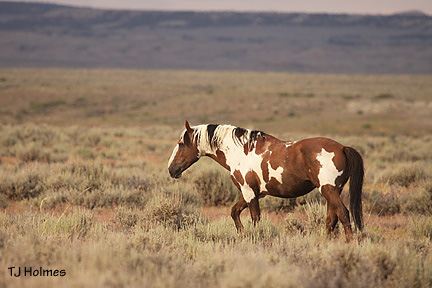
Handsome mister
See what I mean about his color? Tell me what you think!

Family man
He also has a solid bay mare and her seal brown foal. I’ll take this opportunity to say this is just the first round of photos until I can get more tweaked, as well as to encourage everyone to keep an eye on Pam’s blog (http://nickolesphotography.wordpress.com/) for her narrative of our visit, which, for her and Tom, included a visit to Wyoming’s Adobe Town herd!

Another one
Seriously, I could take pictures of this guy all day!
With a rapidly setting sun and clouds still filling most of the sky, we headed out. Pam recognized the birds flying past us at one point and got out to identify burrowing owls! Cool! The next day, Amanda and I saw a doe with twins just outside Maybell, then a golden eagle and a coyote inside the herd area! As if the wild horses weren’t enough, it was such a treat to see other wildlife during our visit.
I have to mention the event that took me north in the first place. A few posts ago, I mentioned the fundraising and book-signing event at Zuma’s Rescue Ranch near Denver. Michael Blake – you know him as the author and screenplay writer of “Dances with Wolves,” book and movie – was there almost immediately after completing a recent whirlwind book tour. He not only offered his new book, Twelve the King, and other books including Dances With Wolves and its sequel, The Holy Road, and Indian Yell, he talked about the importance of protecting our American mustangs in the wild. Twelve is about the mustang stallion he rescued from Palomino Valley in Nevada in 1991. An amazing horse; an amazing story. Read Pam’s blog for another amazing story.


